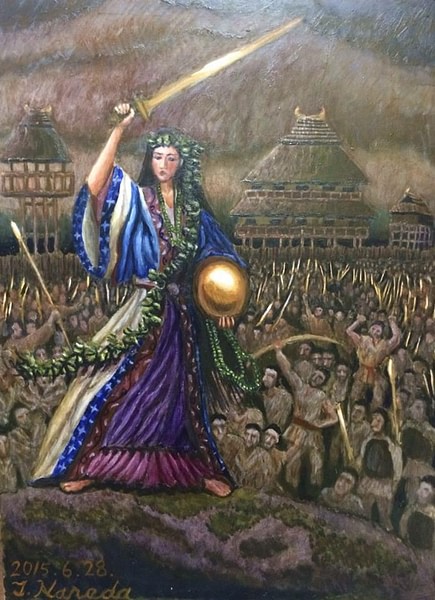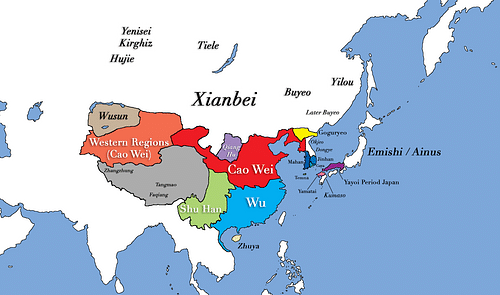Queen Himiko
Queen Himiko, also known as Pimiko or Pimiku (183? - 248 CE), was a 3rd-century CE ruler of the territory in ancient Japan known as Hsieh-ma-t'ai or Yamatai, later to be known as Yamato. Considered by the Chinese as the ruler of all of Japan or Wa, given her state's power, she exchanged diplomatic embassies with the ruling Wei dynasty. A semi-legendary figure, Himiko is curiously absent from Japanese historical records but does appear briefly in Chinese histories. Himiko was noted for being a shaman queen, unmarried, and living in a fortress where she was served by 1,000 women.

Queen Himiko
Yamatai
Himeko's name in archaic Japanese means Sun Child or Sun Daughter and probably alludes to her divine descent from Amaterasu, the Shinto sun goddess, as all Japanese rulers would later be identified as being descendants of. Scholars do not agree on the exact location of Queen Himiko's state Hsieh-ma-tai/Yamatai. A minority place it in north Kyushu, but the majority consider the Nara region as the most likely candidate. In Japan, at the time of her reign during the 3rd century CE, there were around 100 kingdoms spread across the islands. It seems that Himiko's state was the most powerful of these and may have led a loose federation of 30 states as the contemporary Chinese state recognised her as, in effect, the ruler of all of the Japanese islands.
SCHOLARS CONTINUE TO DEBATE WHO HIMIKO WAS, WHERE SHE MIGHT HAVE RULED & WHAT IS THE LOCATION OF HER FABLED BURIAL MOUND BUT WITHOUT ANY CONSENSUS EVER BEING REACHED.
Historical References
Queen Himiko's role as a shamaness or high priestess, not an uncommon practice for rulers in early East Asian cultures, is alluded to in Chinese sources. The Chinese history book Wei Chih ('History of the Kingdom of Wei') which was written in 297 CE. There, we are told Himiko "occupied herself with magic and sorcery, bewitching the people" (Henshall, 152). Japanese dynastic histories such as the Kojiki ('Record of Ancient Things'), compiled in 712 CE, and the Nihon Shoki ('Chronicle of Japan' and also known as the Nihongi), compiled in 720 CE, do not mention Queen Himiko by name. It is recorded in the Nihon Shoki that the Queen (although not named) sent a tributary embassy to the Wei kingdom of China in 238 CE:
In the sixth month of the third year of Ching-ch'u [238 CE] in the reign of Emperor Ming Ti, the queen of the Wa sent the grandee Nashonmi and other; they visited the prefecture and asked permission to proceed to the emperor's court and present tribute. The governor, Teng Hsia, dispatched an official who escorted them to the capital. (Keene, 72)
Following this embassy, the Chinese gave Himiko the honour of the title 'Queen of Wa, Friendly to Wei' and a gold seal. Other gifts given to the queen in return for her tribute of fine cloth and slaves to the region's great power included beads, 100 bronze mirrors, and swords, some items of which may have become part of the Japanese imperial regalia. Himiko sent two more embassies to China in 243 and 247 CE. For all these good relations there would not be any more contact between the two states until the Sui Dynasty of the 7th century CE.

Three Kingdoms Period of China and the Rise of Xianbei in the year 229 CE
Biographical Details
According to the Wei Chih, Queen Himiko was chosen by her people following a turbulent period of 70 or 80 years beset by uprisings and warfare. Although enjoying a peaceful reign, the queen was said to have never married and lived as a recluse in a mighty towered fortress which was guarded from the outside by 100 men. Inside, the monarch was served by 1,000 female servants. Himiko did have one male attendant who served her food and acted as her point of contact with her kingdom and other states. She also left affairs of state to or at least shared them with her younger brother while she devoted herself to shamanism.
It may be that this romantic description of seclusion and leaving politics to her brother is the result of author bias - it was common for Japanese rulers not to receive ambassadors, for example, which would lead Chinese visitors with the impression of a retiring monarch and later (male) writers were keen to establish a male-only line of sovereigns on the Japanese throne.
When Himiko died in 248 CE, it is said that she was interred in a tomb measuring 100 'paces' (equivalent to 150 metres) and that 100 slaves were sacrificed in her honour. With her death, Japan moved from the Yayoi Period (c. 300 BCE - c. 250 CE) to the Kofun Period (c. 250-538 CE).
Legacy
Scholars continue to debate Himiko's role in Japanese history: who she was, where she might have ruled and what is the location of her fabled burial mound but without any consensus ever being reached on all three points. The ancient queen also continues to appeal to the imagination of the wider Japanese public and is easily the most recognisable name in history for the majority of Japanese school children. With regional beauty contests being held in her name, Tarot cards featuring her image, and manga comics starring the queen in various guises ranging from an erotic character to a symbol of female rulership, the legend of Himiko is sure to live on for a good while yet.
Queen Himiko (and the Kingdom of Yamatai) | History of Japan 7
Bibliography
Ebrey, P.B. Pre-Modern East Asia. Cengage Learning, 2008.
Edwards, W. "In Pursuit of Himiko. Postwar Archaeology and the Location of Yamatai." Monumenta Nipponica, Vol. 51, No. 1 (Spring, 1996), pp. 53-79.
Henshall, K. Historical Dictionary of Japan to 1945. Scarecrow Press, 2013.
Sansom, G. A History of Japan to 1334. Stanford University Press, 1958.
Translations
We want people all over the world to learn about history. Help us and translate this definition into another language! So far, we have translated it to: Malay, Turkish, French
About the Author
Mark Cartwright
Mark is a history writer based in Italy. His special interests include pottery, architecture, world mythology and discovering the ideas that all civilizations share in common. He holds an MA in Political Philosophy and is the Publishing Director at WHE.
https://www.worldhistory.org/Queen_Himiko/

